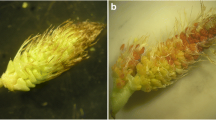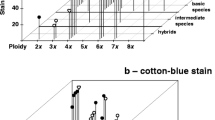Summary and conclusions
A new occurrence of mut.formosa together with the parental form,Oe. pratincola Etypica, and hybrids of both with other species were studied cytologically and genetically to determine the nature of the changes occurring when mut.formosa is produced.
The egg complex,α, oftypica was found to have chromosomes 1.2 (carryingR, the gene for red nerves), 3.4 (carryingp, non-punctate, and probably carrying the normal allelomorph off), 7.10, 8.9, 11.12, and either 5.14 and 6.13 or 5.13 and 6.14.
The pollen complex,β, oftypica was found to have chromosomes 1.4 (carryingf, the gene for revolute leaves), 7.8 and 13.14, with the remaining chromosomes undetermined but with the geneP s (punctate stems, striped bud cones) in the 3-end of a chromosome designated 3.x.
The egg complex of mut.formosa,f α′, was found to have five chromosomes in common withα oftypica, but chromosomes 1.2 and 3.4 have been replaced by 1.4 (carryingf) and 2.3 (carryingR andP s). In this replacement, chromosome 1.4 has come directly fromβ oftypica, while chromosome 2.3 represents a new chromosome made up of the 2-end of 1.2 fromα and the 3-end of 3.x fromβ.
The regular occurrence of mut.formosa with a frequency of about thirteen per thousand in the progeny oftypica is accounted for on the assumption that the mid-regions of chromosome 1.2 ofα and 3.x ofβ are homologous and occasionally cross-over. The distribution of such “interstitial segments” inOenothera chromosomes is discussed.
Further evidence is presented tending to show that mut.setacea is the homozygousβ.β segregant fromtypica, a conclusion already reached by Blanchard (1929).
Similar content being viewed by others
References
Bartlett, H. H. (1915). “Mass mutation inOenothera pratincola.”Bot. Gaz. 60, 425–56.
Blanchard, F. C. (1929). “The genetical constitution ofOenothera pratincola and its revolute-leaved mutations.”J. Wash. Acad. Sci. 19, 115–25.
Brink, R. A. andCooper, D. C. (1932). “A strain of maize homozygous for segmental interchanges involving both ends of theP-Br chromosome.”Proc. nat. Acad. Sci., Wash.,18, 441–7.
Cleland, R. E. (1928). “The genetics ofOenothera in relation to chromosome behaviour, with special reference to certain hybrids.”Verh. V. int. Kongr. Vererb. (Z. indukt. Abstamm.- u. VererbLehre, suppl. 2), pp. 554–67.
—— (1933). “Predictions as to chromosome configuration, as evidence for segmental interchange inOenothera.”Amer. Nat. 67, 407–18.
Cleland, R. E. andBlakeslee, A. F. (1930). “Interaction between complexes as evidence for segmental interchange inOenothera.”Proc. nat. Acad. Sci., Wash.,16, 183–9.
—— —— (1931). “Segmental interchange, the basis of chromosomal attachments inOenothera.”Cytologia,2, 175–233.
Cleland, R. E. andOehlkers, F. (1929). “New evidence bearing upon the problem of the cytological basis for genetical peculiarities of the Oenotheras.”Amer. Nat. 63, 497–510.
Cobb, F. (1921). “A case of Mendelian inheritance complicated by heterogametism and mutation inOenothera pratincola.”Genetics,6, 1–42.
Cobb, F. andBartlett, H. H. (1919). “On Mendelian inheritance in crosses between mass-mutating and non-mass-mutating strains ofOenothera pratincola.”J. Wash. Acad. Sci. 9, 462–83.
Darlington, C. D. (1929). “Ring formation inOenothera and other genera.”J. Genet. 20, 345–63.
—— (1931). “The cytological theory of inheritance inOenothera.” Ibid.24, 405–74.
—— (1932). “The behaviour of interchange heterozygotes inOenothera.”Proc. nat. Acad. Sci., Wash.,19, 101–3.
Emerson, S. (1931a). “The inheritance of certain characters inOenothera hybrids of different chromosome configurations.”Genetics,16, 325–48.
—— (1931b). “Genetic and cytological studies onOenothera. II. Certain crosses involvingOe. rubricalyx andOe. ‘franciscana sulfurea’.”Z. indukt. Abstamm.- u. VererbLehre,59, 382–94.
—— (1932). “Chromosome rings inOenothera, Drosophila and maize.”Proc. nat. Acad. Sci., Wash.,18, 630–2.
Emerson, S. andSturtevant, A. H. (1931). “Genetic and cytological studies onOenothera. III. The translocation interpretation.”Z. indukt. Abstamm.- u. VererbLehre,59, 395–419.
—— —— (1932). “The linkage relations of certain genes inOenothera.”Genetics,17, 393–412.
Gerhard, K. (1929). “Genetische und zytologische Untersuchungen anOenothera grandiflora Ait.”Jena. Z. Naturw. 64, 283–338.
Kulkarni, C. G. (1929). “Meiosis in pollen mother cells of strains ofOenothera pratincola Bartlett.”Bot. Gaz. 87, 218–59.
Lewitsky, G. A. andAraratian, G. A. (1931). “Transformation of chromosomes under the influence of X-rays.”Bull. appl. Bot., Genet. Pl. Breed. 27, 265–303 (English summary).
Patterson, J. T., Stone, W., Bedichek, S. andSuche, M. (1934). “The production of translocations inDrosophila.”Amer. Nat. 68, 359–69.
Renner, O. (1921). “Heterogamie im weiblichen Geschlecht und Embryosackbildung bei den Oenotheren.”Z. Bot. 13, 609–21.
—— (1933). “Zur Kentnis der Letalfaktoren und des Koppelungswechsel der Oenotheren.”Flora (N.S.),27, 215–50.
Renner, O. andCleland, R. E. (1933). “Zur Genetik und Cytologie derOenothera chicaginensis und ihrer Abkömmlinge.”Z. indukt. Abstamm.- u. VererbLehre,66, 275–318.
Rudloff, C. F. (1931). “Zur Polarisation in der Reduktionsteilung heterogamer Oenotheren. I. Die Embryosack-Entwicklung und ihre Tendenzen.” Ibid.58, 422–33.
Sansome, E. R. (1932). “Segmental interchange inPisum sativum.”Cytologia,3, 200–19.
—— (1933). “Segmental interchange inPisum. II.” Ibid.5, 15–30.
Shull, G. H. (1923). “Linkage with lethal factors the solution of theOenothera problem.”Eugenics, Genet. and the Family,1, 86–99.
Stadler, L. J. (1933). “On the genetic nature of induced mutations in plants. II. A haplo-viable deficiency in maize.”Res. Bull. Mo. agric. Exp. Sta. No. 204, 29 pp.
Sturtevant, A. H. (1931). “Genetic and cytological studies onOenothera. I.Nobska, Oakesiana, Ostraea, Shulliana, and the inheritance of old-gold flower-colour.”Z. indukt. Abstamm.- u. VererbLehre,59, 365–80.
de Vries, H. (1919). “Oenothera rubrinervis, a half-mutant.”Bot. Gaz. 67, 1–26.
Author information
Authors and Affiliations
Additional information
A report of experiments conducted in part at the California Institute of Technology and in part at the Botanical Gardens of the University of Michigan. I wish to take this opportunity to thank Prof. H. H. Bartlett and Dr Frieda Cobb Blanchard of the University of Michigan for some of the material utilised, for the facilities placed at my disposal and for their general help and criticism.
Rights and permissions
About this article
Cite this article
Emerson, S. A genetic and cytological analysis ofOenothera pratincola and one of its revolute-leaved mutations. Journ. of Genetics 32, 315–342 (1936). https://doi.org/10.1007/BF02982684
Issue Date:
DOI: https://doi.org/10.1007/BF02982684




